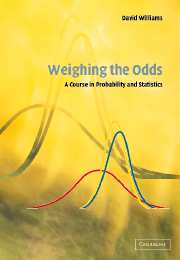Book contents
- Frontmatter
- Contents
- Preface
- 1 Introduction
- 2 Events and Probabilities
- 3 Random Variables, Means and Variances
- 4 Conditioning and Independence
- 5 Generating Functions; and the Central Limit Theorem
- 6 Confidence Intervals for one-parameter models
- 7 Conditional pdfs and multi-parameter Bayesian Statistics
- 8 Linear Models, ANOVA, etc
- 9 Some further Probability
- 10 Quantum Probability and Quantum Computing
- Appendix A Some Prerequisites and Addenda
- Appendix B Discussion of some Selected Exercises
- Appendix C Tables
- Appendix D A small Sample of the Literature
- Bibliography
- Index
2 - Events and Probabilities
Published online by Cambridge University Press: 05 June 2012
- Frontmatter
- Contents
- Preface
- 1 Introduction
- 2 Events and Probabilities
- 3 Random Variables, Means and Variances
- 4 Conditioning and Independence
- 5 Generating Functions; and the Central Limit Theorem
- 6 Confidence Intervals for one-parameter models
- 7 Conditional pdfs and multi-parameter Bayesian Statistics
- 8 Linear Models, ANOVA, etc
- 9 Some further Probability
- 10 Quantum Probability and Quantum Computing
- Appendix A Some Prerequisites and Addenda
- Appendix B Discussion of some Selected Exercises
- Appendix C Tables
- Appendix D A small Sample of the Literature
- Bibliography
- Index
Summary
We start again ‘from scratch’, developing Probability in the only order that logic allows.
This chapter is important, but not too exciting (except in discussion of what is perhaps the most brilliant piece of magical trickery in Maths): important in that it covers the Addition Rule; not too exciting in the main because it does not go beyond the Addition Rule to the Multiplication Rules involving conditioning and independence. Without those Multiplication Rules, we can assign actual probabilities to events only in an extremely limited set of cases.
As mentioned at Discussion 25B, we are concerned with constructing a Mathematical Model for a Real-World Experiment: we make no attempt to define probability in the real world because such an attempt is doomed. In the mathematical model, probability ℙ is just a function which assigns numbers to events in a manner consistent with the Addition Rule (and with conditional-probability considerations) – and nothing more. And events are just (technically, ‘measurable’) subsets of a certain set, always denoted by Ω. This set is called the sample space and it represents the set of all possible outcomes ω of our experiment. In Statistics, the experiment has been performed, and we have some information – in many cases, all information – about the actual outcome ωact, the particular point of Ω actually ‘realized’.
- Type
- Chapter
- Information
- Weighing the OddsA Course in Probability and Statistics, pp. 35 - 46Publisher: Cambridge University PressPrint publication year: 2001



